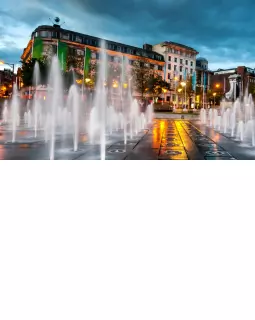London is full of popular attractions that draw in visitors from around the world. But fewer people know of the Necropolis Railway Station in Waterloo, which once hosted London’s trains for the dead.
The dark history of the station will inspire rail enthusiasts and history lovers alike.
This is the story of the Necropolis Railway in London. All that remains now is the building that housed the station, which you can walk right up to today.
What was the Necropolis Railway in London?

The Necropolis Railway in London transported bodies to burial grounds in Surrey. The service ran most days from Waterloo to Brookwood Cemetery.
The Necropolis Railway carried up to 2,000 bodies a year, transporting the dead in one carriage and their mourners in others. Over 87 years, the train carried over 200,000 bodies to their burial site.
What is the story behind the Necropolis Railway in London?
In 1801, London had a population of around one million. By 1851, this population had grown to nearly 2.5 million. As the city brimmed with people, so did its graveyards.
Secretions from the decaying bodies in crammed graves seeped into London’s water supply. This infected this water and caused even more deaths across the city. The more people died, the more the graveyards filled.
The death toll rose further between 1846 and 1849 when a cholera epidemic killed 14,601 people. At this point, Parliament knew they had to amend the laws.
They launched the “Burials Act” to forbid burials in London’s central built-up areas. Instead, Parliament arranged the development of cemeteries outside London’s city centre.
One of these cemeteries, Brookwood Cemetery, opened in Surrey in 1852. Its founders made efforts to make the cemetery so attractive that mourners would only want Brookwood for their loved ones.
They designed the cemetery to create a perpetual feeling of spring, selecting plants and trees in line with this image. However, the cemetery was 23 miles outside London. This made for expensive, long horse-drawn hearse journeys of up to 12 hours each way.
To bypass this problem, the company’s founders turned to London’s new railway system. This enabled them to transport coffins and mourners between London and Surrey within 50 minutes.
Why did the Necropolis Railway in London close down?
Demand for the Necropolis in London began to die down in the 1900s. Several other cemeteries were attracting competitors by that point. In the meantime, the invention of cars allowed for more convenient transport.
Sunday services stopped in 1900. By the 1930s, only one or two trains departed to Brookwood each week. The last train to the cemetery departed London on 11 April 1941.
Five days later, a German bombing raid destroyed the company’s rolling stock. The bombing raid also destroyed much of the building at 121 Westminster Bridge Road. The station officially closed on 11 May 1941.
However, visitors can still visit the site and look through the gates beneath the arch. They will see the tiled driveway walls that led to the station.
London offers several attractions for rail enthusiasts. Once you’ve visited the Necropolis Railway Station site, you could visit the London Transport Museum.
There’s also the Brockwell Park Miniature Railway and the London Museum of Water and Steam.
Where was the Necropolis Railway in London?
In 1854, the London Necropolis and National Mausoleum Company built the Cemetery Station. They built the station at 188 Westminster Bridge Road, between Westminster Bridge and York Street (now Leake Street).
The Necropolis Railway in London started operations that same year. Trains began running from the site, which was adjacent to Waterloo Bridge Station (now Waterloo).
This site offered three major benefits.
First, it was close enough to the River Thames for bodies to arrive at the station by river. This water transport was cost-effective and easy. Especially compared to carrying bodies through London’s swarming streets.
Three nearby bridges also made it easy for mourners to travel from the north of the river by road. These were the Waterloo, Blackfriars, and Westminster Bridges.
Finally, the arches of the brick viaduct that carried trains in and out of the station made great mortuaries. Bodies could wait here before the funerals.
The locals didn’t like the bodies piling up close to their homes, but the London Necropolis Company disregarded their objections.
Funeral parties would depart Waterloo and wind through woodlands and countryside towards Surrey. The idea was that the greenery would be peaceful for those in mourning.
Mourners would pass by Richmond Park and Hampton Court and arrive at Necropolis Junction in Surrey just under an hour later.
Where did the Necropolis Railway move to?
Waterloo Station underwent expansive rework in the 1890s. The Cemetery Station would have prevented a proposed enlargement of the viaduct out of Waterloo Station. But the LSWR made a deal with the London Necropolis Company.
The LSWR offered to build a new station for the London Necropolis Company in exchange for the original site. The company agreed as long as they could design the new terminus.
In 1902, the new station opened on the other side of Westminster Bridge Road at number 121. This is halfway between Lower Marsh and Lambeth North Station.
Although the Necropolis Railway closed decades ago, the building on the second site still survives. Few people who pass by realise this is the hub of one of England’s most historic, unusual railway stations.
What is the oldest train station still in use?

Broad Green Station in Liverpool is the oldest train station still in use. The station opened on 15 September 1830 on the Liverpool and Manchester line, which was the world’s first passenger railway.
Rail enthusiasts enjoy visiting the fully operating station. Dignified visitors have passed through the station, and various tragedies have occurred here.
Which historic figures visited Broad Green Station?
In 1860, Prime Minister William Gladstone caught a train from Broad Green Station to tour Scotland. A large crowd cheered him off, and he leaned out of the carriages to shake hands with supporters.
In 1872, Queen Victoria’s son Prince Arthur arrived at the station for a four-day visit to Liverpool. During his stay, he opened Sefton Park and attended a Grand Dress Ball at St George’s Hall.
What are the tragic stories of Broad Green Station?
In 1860, a London to Liverpool Express passenger leant out of the window as the train sped through the station. He caught his head on a lamp attached to the side of a stationary train, which almost decapitated him.
When the train arrived at Edge Hill, his body was found hanging out of the window.
Seven years later, in 1867, a train ran over a servant girl. She had been crossing the line to reach the post office.
In 1873, another train killed the Brazilian Vice-Consul Joas Baptiste Cafferena. He had been crossing the line to catch a train on the night of Christmas Eve.
The same thing happened to newlyweds Mr and Mrs Green in 1867. The train carried Mr Green’s body about a mile up the track.
Today, raised platforms and a subway that runs under the track make Broad Green Station much safer. Over half a million commuter passengers use the station every year.
Planning your visit to London by train with Avanti
Visiting the Necropolis Railway in London and the city’s other rail attractions is easy via train.
Book our Advance Tickets to get the best deals on train fares. Our Priority Ticket Alerts will update you when the cheapest advance tickets are available.
You can also use our Best Fare Finder. This will work out whether two advance single tickets or one flexible return ticket will be cheaper.
Travelling at Off-Peak times is often a great way to secure cheap London train tickets. And you can save even more with a Family Ticket or Railcard.
You can also join Club Avanti to get member rewards. These rewards include free tickets, 10% off food and beverages, a free hot drink, and 10% off your next journey.


















